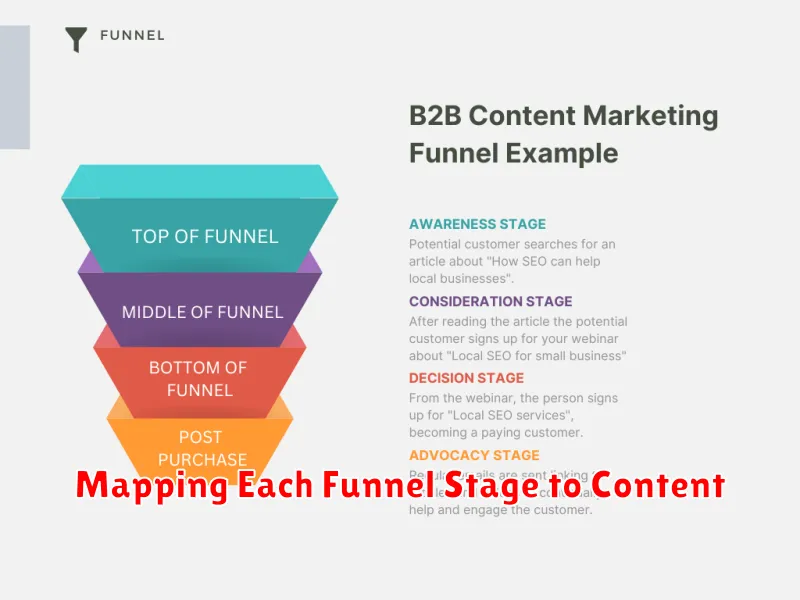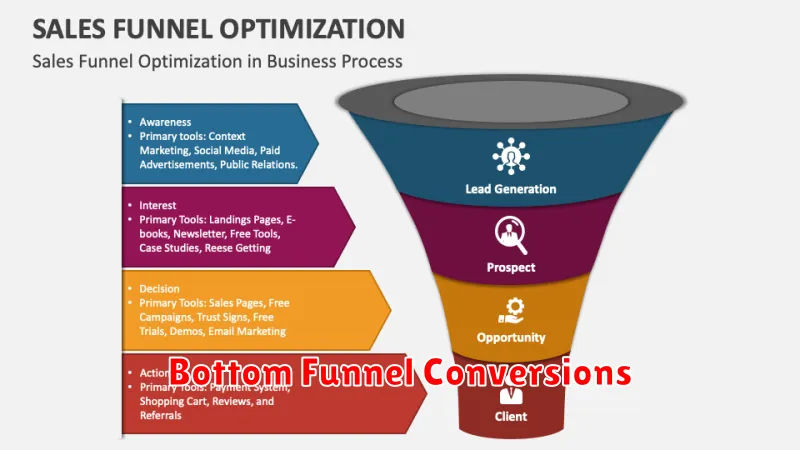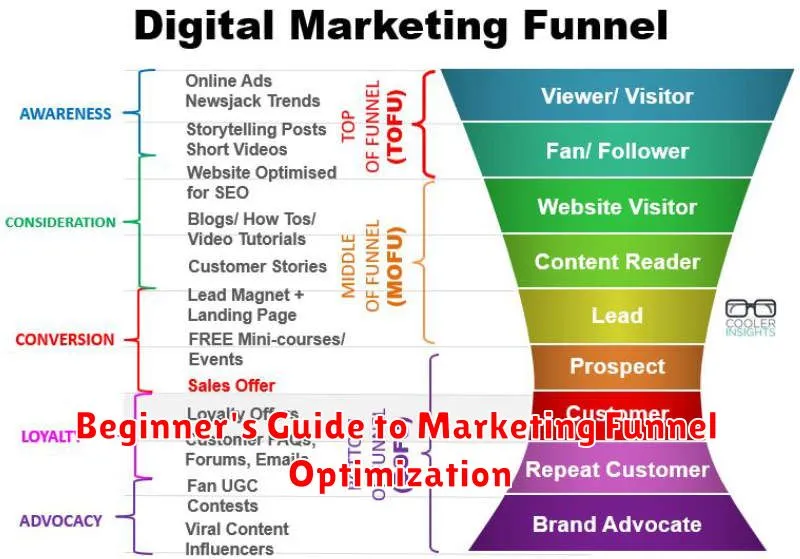A marketing funnel is a crucial element for any business aiming to convert leads into paying customers. Marketing funnel optimization is the process of improving each stage of this funnel to increase conversions and ultimately, revenue. This beginner’s guide provides a comprehensive overview of marketing funnel optimization, breaking down the key components and providing actionable strategies to maximize its effectiveness. Whether you’re new to digital marketing or seeking to refine your existing funnel, understanding the principles outlined here will help you attract, engage, and convert your target audience more effectively.
This guide delves into the essential stages of a marketing funnel, from the initial awareness stage to the final purchase decision. By exploring the metrics that matter, you’ll gain insights into how to identify areas for improvement. Learn how to tailor your messaging, content, and offers to resonate with your audience at each stage, leading to higher conversion rates and a more robust return on investment (ROI). Get ready to transform your marketing funnel from a passive lead generator into a powerful engine for business growth with this practical beginner’s guide to marketing funnel optimization.
Understanding the Customer Journey Funnel
The customer journey funnel represents the various stages a customer goes through from initial awareness of a product or service to ultimately making a purchase. This model helps businesses understand customer behavior and tailor their marketing efforts accordingly. The traditional funnel consists of several key stages: Awareness, where potential customers become aware of a brand or product; Consideration, where they evaluate different options and compare solutions; Decision, where they choose a specific product or service; and finally, Action, where the purchase is made. Understanding each stage is crucial for effective marketing.
However, the modern customer journey is often less linear than the traditional funnel suggests. Customers may enter and exit at various points, revisit previous stages, or bypass stages altogether. The rise of digital channels and readily available information empowers customers to conduct their own research and engage with brands on their terms. Therefore, it’s important for businesses to adapt their strategies to address this non-linearity and focus on building meaningful relationships with customers throughout their journey. This involves providing valuable content, personalized experiences, and seamless interactions across all touchpoints.
By analyzing customer behavior at each stage of the journey, businesses can optimize their marketing efforts. This might involve targeted advertising during the awareness phase, providing in-depth product information during the consideration phase, offering incentives during the decision phase, and ensuring a smooth checkout process during the action phase. Ultimately, understanding the customer journey funnel, both traditional and modern iterations, enables businesses to effectively connect with customers, nurture leads, and drive conversions.
Mapping Each Funnel Stage to Content

Effectively guiding potential customers through the sales funnel requires targeted content tailored to each stage. At the awareness stage, focus on educational content that addresses common pain points and introduces your brand as a solution. This might include blog posts, infographics, or short videos explaining industry trends and offering valuable insights. The goal is to establish credibility and capture the interest of your target audience.
During the consideration stage, prospects are actively evaluating solutions. Provide content that delves deeper into the benefits of your product or service, addressing specific needs and demonstrating its value proposition. Case studies, white papers, webinars, and product demos are effective tools at this stage. Focus on highlighting your unique selling points and showcasing how you differentiate from competitors. Building trust and demonstrating expertise are key.
Finally, in the decision stage, potential customers are ready to make a purchase. Offer content that reinforces their choice and facilitates the buying process. This could include free trials, consultations, testimonials, and comparison charts. Focus on reducing any remaining obstacles and providing a clear call to action, making it easy for prospects to convert into paying customers.
Top of Funnel Awareness Tactics
Top-of-funnel marketing focuses on generating awareness and interest in your brand among a wide audience. It’s the first stage of the sales funnel where potential customers may not even know they have a problem your product or service solves. The primary goal here is to educate and inform, positioning your brand as a valuable resource and building initial recognition.
Effective top-of-funnel tactics often involve content marketing, social media engagement, and public relations efforts. For example, creating blog posts, infographics, and videos that address common industry questions can attract a broad audience. Sharing engaging content on social media platforms and participating in relevant online communities can increase visibility and establish thought leadership. Public relations efforts such as press releases and media outreach can also help generate broader awareness.
Ultimately, successful top-of-funnel activities lay the foundation for future conversions. By capturing the attention of a larger audience and providing valuable information, you build a pipeline of potential customers who can be nurtured through the subsequent stages of the sales funnel. Measurable results at this stage often include website traffic, social media engagement, and brand mentions.
Middle of Funnel Engagement Tips
The middle of the funnel (MOFU) is where prospects have identified a problem and are actively researching solutions. Engagement during this stage focuses on providing valuable information that positions your product or service as the best fit. This is achieved by offering in-depth content such as case studies, webinars, and product demos that showcase the benefits and address specific pain points. Building trust and credibility is critical during this phase.
Effective MOFU engagement relies on understanding your audience’s needs and tailoring content to address their specific questions. Content should move beyond general awareness and delve into the specifics of how your offering solves their problems. Targeted emails, interactive tools, and personalized content recommendations can significantly enhance engagement. Measuring engagement through metrics like time on page, download rates, and webinar attendance is essential to optimize your strategy.
Nurturing leads through the MOFU requires a strategic approach. Provide clear calls to action that guide prospects towards the next stage of the buyer’s journey, such as requesting a consultation or signing up for a free trial. By consistently delivering valuable content and demonstrating your expertise, you can effectively move prospects closer to conversion.
Bottom Funnel Conversions

Bottom-of-the-funnel (BOFU) conversions represent the final stage of the sales process where prospects are highly qualified and ready to purchase. These conversions focus on turning interested leads into paying customers. Key metrics to track at this stage include sales conversions, trial-to-paid conversions, and deal closures. Optimizing for BOFU conversions requires compelling offers, streamlined checkout processes, and strong customer support to address any last-minute hesitations.
Strategies to improve BOFU conversion rates involve targeting users with highly personalized messaging based on their past interactions and demonstrated interests. This might include retargeting campaigns, exclusive offers for returning visitors, and clear calls-to-action encouraging immediate purchase. Focusing on building trust and addressing potential objections is crucial at this stage. Testimonials, case studies, and strong guarantees can help solidify a prospect’s decision to buy.
Examples of BOFU content and offers include free trials with easy upgrade paths, product demos highlighting key features and benefits, and limited-time discounts or promotions to incentivize immediate action. Making the purchasing process as frictionless as possible is essential. This involves minimizing form fields, offering various payment options, and ensuring a smooth checkout experience across all devices.
Post-Purchase and Retention
Post-purchase experience is crucial for customer retention. This encompasses everything from order fulfillment and delivery to customer service interactions and product usage. A positive post-purchase experience builds loyalty and encourages repeat purchases, while a negative one can lead to churn and negative word-of-mouth. Focusing on timely delivery, easy returns, and proactive customer support are key elements of a successful post-purchase strategy.
Effective retention strategies aim to cultivate ongoing customer relationships. This can involve personalized communication, exclusive offers, loyalty programs, and valuable content that keeps customers engaged with the brand. By understanding customer needs and preferences, businesses can tailor their retention efforts to maximize their impact and foster long-term customer value.
Measuring the success of post-purchase and retention efforts involves tracking key metrics such as customer lifetime value (CLTV), churn rate, and repeat purchase rate. Analyzing these metrics helps businesses identify areas for improvement and optimize their strategies to enhance customer satisfaction and drive sustainable growth.
Using CRM Tools for Funnel Tracking
CRM (Customer Relationship Management) tools offer powerful capabilities for tracking sales funnels. By logging interactions and automating processes, CRMs provide a centralized view of where prospects are in the buying journey. This allows sales teams to understand conversion rates at each stage, identify bottlenecks, and adjust strategies to improve overall performance. With detailed reporting and analytics, CRMs can pinpoint areas for improvement and highlight successful tactics.
Businesses can leverage CRMs to segment leads based on various criteria, allowing for targeted marketing campaigns and personalized communication. By tracking engagement metrics, sales reps can prioritize leads with high potential and nurture them through the funnel more effectively. This personalized approach increases the chances of converting prospects into paying customers, ultimately boosting revenue and ROI.
Implementing a CRM for funnel tracking empowers businesses with valuable data-driven insights. By monitoring key performance indicators (KPIs) such as conversion rates, deal velocity, and customer lifetime value, businesses can make informed decisions about their sales and marketing efforts. This leads to a more efficient and effective sales process, contributing to overall business growth.
Heatmaps and Funnel Visualization Tools
Heatmaps and funnel visualizations are powerful tools for understanding user behavior on websites and in applications. Heatmaps visually represent user interaction data, such as clicks, mouse movements, and scroll depth, using color gradients. Hotter colors (e.g., red, orange) indicate areas of high activity, while cooler colors (e.g., blue, green) represent areas with less engagement. This allows you to quickly identify key areas of interest and potential usability issues. For example, a heatmap might reveal that users are consistently clicking on a non-clickable element, suggesting a design flaw.
Funnel visualization, on the other hand, helps track user progress through a defined sequence of steps, such as a checkout process or a signup flow. Each step in the funnel represents a specific action, and the visualization shows the number of users who complete each step. This helps identify drop-off points where users abandon the process. By pinpointing these bottlenecks, you can optimize the user experience and improve conversion rates. For instance, a funnel might show a significant drop-off at the payment stage, indicating a potential issue with the payment gateway or form.
Used together, heatmaps and funnel visualizations provide a comprehensive view of user behavior. Heatmaps help understand how users interact with specific pages, while funnels reveal where users drop off in multi-step processes. This combined insight allows for data-driven decisions to improve website design, enhance user experience, and ultimately, achieve business objectives.
Funnel Split Testing
Funnel split testing, also known as A/B testing for funnels, is the process of comparing two or more versions of a sales or conversion funnel to determine which performs better. This involves directing traffic to different variations of the funnel, then analyzing key metrics like conversion rates, bounce rates, and average order value to identify the most effective version. By isolating and testing individual elements or stages within the funnel, you can pinpoint areas for improvement and optimize the entire process for increased conversions and revenue.
A typical funnel split test might involve changes to the copy, design, call to action, or even the order of steps within the funnel. For example, you could test a shorter form against a longer form, a different headline on a landing page, or a new checkout process. Careful tracking and analysis of the results are crucial to identify the winning variation and implement the changes that drive the best results.
The benefits of funnel split testing are numerous. It helps to reduce cart abandonment, improve customer lifetime value, and ultimately increase profitability. By continually testing and optimizing your funnel, you can ensure that you are providing the best possible user experience and maximizing your conversion potential.
Metrics That Matter at Each Stage
Early Stage startups should focus on traction. Key metrics include user growth, activation rate, and customer acquisition cost (CAC). Demonstrating a strong product-market fit and efficient customer acquisition is crucial at this phase.
Growth Stage companies prioritize scalability and revenue growth. Metrics like customer lifetime value (CLTV), monthly recurring revenue (MRR), and churn rate become increasingly important. Understanding customer retention and revenue generation helps determine long-term sustainability.
Mature Stage businesses emphasize profitability and market share. Key metrics shift to net profit margin, return on investment (ROI), and market penetration. Maintaining a competitive edge and maximizing returns for investors become the primary focus.

